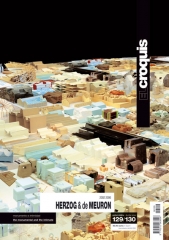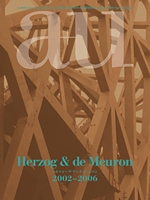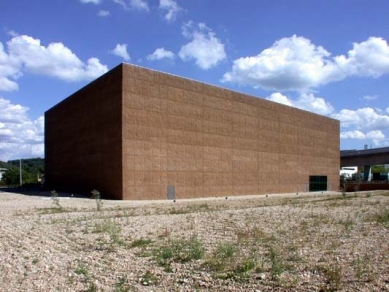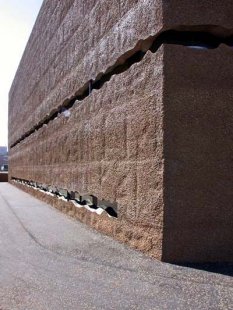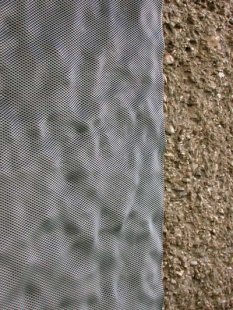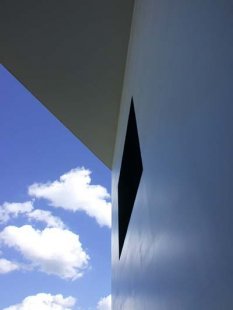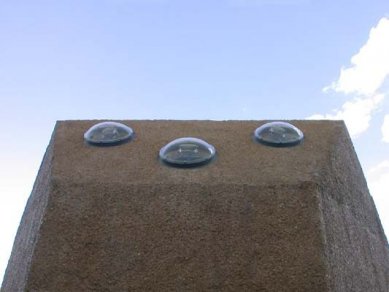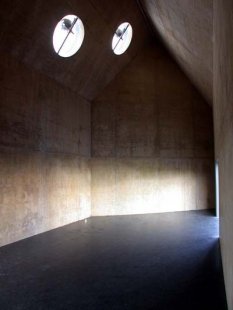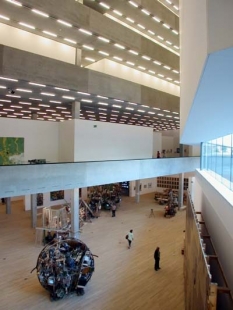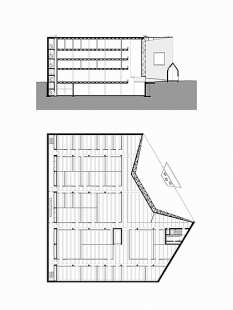
Schaulager®

In Seattle, I discovered that there are people for whom the question of money no longer plays any role. They earn money through speculation, hard work, or simply inherit it. Once they have had their fill of money, they begin to have desires and needs that are different from material ones. Such people accumulate in Basel. They have a weakness for art, and this is evident throughout the city. The latest addition to the family of Basel museums is Schaulager®. The architects were approached by the heiress of the pharmaceutical company Roche to build a storage facility for their collections. They approached the task with their characteristic playfulness. They redefined the assignment and devised a new hybrid museum building.
The clay cube cost an unimaginable 80 million francs (FOG would have cost 3-4 times more). I cannot forgive the authors for the formal little house at the entrance to the museum. I appreciate the optical illusions in the interior layout, the experimentation with materials and form. In terms of construction, Herzog and de Meuron took another step into architectural heaven.
History of the foundation
Behind the establishment of Schaulager® are two foundations: the Emanuel Hoffmann-Stiftung and the Laurenz-Stiftung. The Emanuel Hoffmann Foundation was established in 1933 by his wife Maja Hoffmann-Stehlin, later Maja Sacher (1896-1989), in memory of her husband, who tragically died in a car accident. The second foundation has a significantly shorter tradition than the seventy-year-old Emanuel Hoffmann Foundation. It was founded in November 1999 by Maja Sacher's daughter, Maja Oeri, with the idea of realizing Schaulager® and was named after the prematurely deceased son of the founder. While the EHS focuses on collecting and mediating works of art, the LS provides funding for the equipment, concept, and operation of Schaulager®. It also finances art-historical seminars at the University of Basel.
Maja Hoffmann (later Sacher) was ahead of her time because she thought contemporaneously and radically. After establishing a collection of contemporary classics such as Picasso, Ernst, Arp, Braque, Dali, or Klee, she directed her collecting activity towards contemporary artists, thus setting a high collecting standard. In 1948, one of Alexander Calder's large mobiles was purchased — the first work by an American artist acquired in the post-war period for a European museum. Maja Sacher's interests were not solely focused on America: in the 1950s, she turned more towards the "Ecole de Paris," where the local artistic friends enjoyed her trust. The legendary exhibition "When Attitudes Become Form," which took place in 1969 at the Bern Kunsthalle,
New typology
In a Just-in-time world, storage is a luxury. The assignment of the Laurenz-Stiftung was to create an institution of a new kind where parts of the collections of the Emanuel Hoffmann Foundation, which are typically not accessible to the public in museums, could be made available. The main requirements were to provide an optimal environment for the conservation of artworks and, to a limited extent, their exhibition. However, the precisely defined program of the client had not yet been realized anywhere. Harry Gugger from H&deM states: "We had no idea what Schaulager® was. Initially, we wanted to create a large space for sculptures and a giant wall for paintings, but that didn’t work. Then we started out from a classic storage facility, which we infected with the dimensions of our program." However, it is not an ordinary large-scale warehouse. The entrance building with a gable roof is empty. Two LED screens measuring 6x8 m provide information about the happenings inside. The external shell measures 70x70x20 m, and this does not include the more than ten-meter excavation into the ground. Harry Gugger further explains: "The external form arose from pedantic adherence to the regulations concerning distances of the building from the property line." The building was constructed on a rectangular structure. The back part of Schaulager® appears as an ordinary block. The outer walls are covered with excavated earth ("Erdwand"). Due to operational conditions, Schaulager® has very few windows. The public entrance to the museum part is a glass crack. Behind it is a wavy niche (another of the pioneering efforts) with a bookstore, ticket office, and café, from which visitors can see into the supply zone through a glass wall. Moreover, visitors are allowed a glimpse into the workspaces of restorers and researchers.
What´s NEXt?
After the retrospective exhibition of Dieter Roth, Schaulager® will host an exhibition about the architects H&deM, prepared by the Canadian CCA Montreal (with an extensive catalog titled Naturgeschichte), and the year after next, a major exhibition by Jeff Wall.
The clay cube cost an unimaginable 80 million francs (FOG would have cost 3-4 times more). I cannot forgive the authors for the formal little house at the entrance to the museum. I appreciate the optical illusions in the interior layout, the experimentation with materials and form. In terms of construction, Herzog and de Meuron took another step into architectural heaven.
Petr Šmídek
History of the foundation
Behind the establishment of Schaulager® are two foundations: the Emanuel Hoffmann-Stiftung and the Laurenz-Stiftung. The Emanuel Hoffmann Foundation was established in 1933 by his wife Maja Hoffmann-Stehlin, later Maja Sacher (1896-1989), in memory of her husband, who tragically died in a car accident. The second foundation has a significantly shorter tradition than the seventy-year-old Emanuel Hoffmann Foundation. It was founded in November 1999 by Maja Sacher's daughter, Maja Oeri, with the idea of realizing Schaulager® and was named after the prematurely deceased son of the founder. While the EHS focuses on collecting and mediating works of art, the LS provides funding for the equipment, concept, and operation of Schaulager®. It also finances art-historical seminars at the University of Basel.
Maja Hoffmann (later Sacher) was ahead of her time because she thought contemporaneously and radically. After establishing a collection of contemporary classics such as Picasso, Ernst, Arp, Braque, Dali, or Klee, she directed her collecting activity towards contemporary artists, thus setting a high collecting standard. In 1948, one of Alexander Calder's large mobiles was purchased — the first work by an American artist acquired in the post-war period for a European museum. Maja Sacher's interests were not solely focused on America: in the 1950s, she turned more towards the "Ecole de Paris," where the local artistic friends enjoyed her trust. The legendary exhibition "When Attitudes Become Form," which took place in 1969 at the Bern Kunsthalle,
New typology
In a Just-in-time world, storage is a luxury. The assignment of the Laurenz-Stiftung was to create an institution of a new kind where parts of the collections of the Emanuel Hoffmann Foundation, which are typically not accessible to the public in museums, could be made available. The main requirements were to provide an optimal environment for the conservation of artworks and, to a limited extent, their exhibition. However, the precisely defined program of the client had not yet been realized anywhere. Harry Gugger from H&deM states: "We had no idea what Schaulager® was. Initially, we wanted to create a large space for sculptures and a giant wall for paintings, but that didn’t work. Then we started out from a classic storage facility, which we infected with the dimensions of our program." However, it is not an ordinary large-scale warehouse. The entrance building with a gable roof is empty. Two LED screens measuring 6x8 m provide information about the happenings inside. The external shell measures 70x70x20 m, and this does not include the more than ten-meter excavation into the ground. Harry Gugger further explains: "The external form arose from pedantic adherence to the regulations concerning distances of the building from the property line." The building was constructed on a rectangular structure. The back part of Schaulager® appears as an ordinary block. The outer walls are covered with excavated earth ("Erdwand"). Due to operational conditions, Schaulager® has very few windows. The public entrance to the museum part is a glass crack. Behind it is a wavy niche (another of the pioneering efforts) with a bookstore, ticket office, and café, from which visitors can see into the supply zone through a glass wall. Moreover, visitors are allowed a glimpse into the workspaces of restorers and researchers.
What´s NEXt?
After the retrospective exhibition of Dieter Roth, Schaulager® will host an exhibition about the architects H&deM, prepared by the Canadian CCA Montreal (with an extensive catalog titled Naturgeschichte), and the year after next, a major exhibition by Jeff Wall.
The English translation is powered by AI tool. Switch to Czech to view the original text source.
0 comments
add comment


